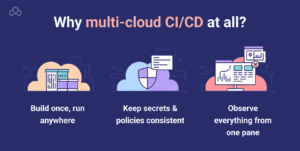Running ci/cd tools in one cloud is hard enough. Running it across two or three cloud computing providers, while keeping security, speed, and spend under control, can feel like juggling knives. The good news: the patterns are repeatable. With the right ci/cd tools, a clear artifact strategy, and a thin control plane, multi-cloud stops being a science project and starts looking like an ordinary delivery system that just… happens to target more than one place.
This article gets concrete: we’ll map the core patterns of cloud-native CI/CD, show a tooling matrix, pinch a few war-stories, and close with concise technical FAQs. Use it as a blueprint or a sanity check against what you already run.
Why multi-cloud CI/CD at all?

Sometimes it’s strategy (avoid lock-in, negotiate pricing). Sometimes it’s reliability (failover between regions/providers). Sometimes you inherited two stacks after an acquisition. Whatever the reason, the pipeline has to do three things well:
1. Build once, run anywhere. Portable artifacts and IaC are non-negotiable.
2. Keep secrets & policies consistent. Don’t let each cloud invent its own rules.
3. Observe everything from one pane. Consistent logs, metrics, and deployment metadata.
That’s the thread we pull through every decision below, especially when picking ci/cd tools and companion DevOps tools.
Architecture in one picture
Imagine a thin control plane in the middle (your CI system, policy engine, and artifact registry). It pushes out to cloud-specific “edges” that actually deploy: Kubernetes clusters, serverless runtimes, VMs, across your chosen cloud computing providers. Artifacts and policies flow outward; telemetry flows back in.
Tooling matrix: what fits where
No single tool is king across all teams. Pick a small, boring set, and standardize. (Too many knobs = fragile.)
Ci/Cd tools tooling matrix
|
Area |
Option (examples) |
Multi-cloud fit |
Strengths |
Watch-outs |
|
CI runners |
GitHub Actions, GitLab CI, Jenkins |
High |
Huge ecosystem; easy self-hosted runners |
Secrets sprawl if unmanaged |
|
CD to K8s |
Argo CD, Flux |
High |
GitOps model; drift detection |
Needs disciplined repo design |
|
Workflows |
Tekton, Argo Workflows |
High |
Cloud-agnostic pipelines |
Learning curve vs simpler SaaS |
|
Progressive delivery |
Flagger, Argo Rollouts, Spinnaker |
Medium–High |
Canary/blue-green baked in |
Extra infra + team training |
|
Policy |
OPA/Gatekeeper, Conftest |
High |
Portable policy-as-code |
Requires org buy-in |
|
IaC |
Terraform, Pulumi |
High |
Provider modules + state mgmt |
State locking, drift, reviews |
|
Secrets |
Vault, SOPS, provider KMS |
High |
Central or envelope patterns |
Rotation discipline needed |
When in doubt, start with a SaaS CI (GitHub/GitLab) and a GitOps CD (Argo/Flux). That pairing covers most cloud computing providers and cloud-native CI/CD cases cleanly.
Build once: portable artifacts, predictable images
Multi-cloud falls apart when every target “just needs a tiny tweak.” Don’t do that.
– Container images: Pin digest, not just tag; use multi-arch builds if ARM/x86 are in play. Keep base images minimal and signed (Sigstore/Cosign).
– Language packs: Cache dependencies aggressively in CI; publish SBOMs so security can scan once.
– Artifacts: Store in a central registry (or cross-replicated registries) with consistent naming (app/env/region/version).
– Mini-case: One team cut pipeline time by ~28% simply by deduplicating build steps and caching language deps at the CI layer, then mirroring images once per release to each provider’s regional registry.
Secrets & policy: one brain, many hands
Every provider has a different vault story. Your job is to make the policy uniform and the storage backends interchangeable.
1. Central policy, local enforcement. Keep rules in Git (OPA/Conftest), run checks during PR and again at deploy time.
2. Short-lived credentials. Prefer workload identity/federation; if you must use static keys, rotate via Vault and log every read.
3. Template once. Helm/Kustomize or Terraform modules should enforce the same labels, probes, securityContext, and network policy across clouds.
If a deployment violates a policy, it should fail the same way in every cloud. That’s the whole point of central brains.
Deployment patterns that survive reboots and audits
Pick one and actually lean into it, don’t mix ten styles.
1. GitOps (Argo CD/Flux): Desired state lives in Git; controllers reconcile clusters to match. Great audit trail, easy drift detection.
2. Workflow-driven (Tekton/Argo Workflows): Pipelines call provider APIs or Helm charts directly; good for bespoke flows and hybrid targets.
3. Progressive delivery: Canary/blue-green with automated metrics checks (Flagger, Argo Rollouts). Safer in multi-cloud when traffic patterns differ.
Observability: your single source of truth
If the dashboards are different per provider, you will miss incidents.
– Shared labels: service, version, env, region, provider on every deploy.
– Central signals: build ID → image digest → deployment hash → runtime metrics; make the chain traceable end-to-end.
– SLOs, not vibes: task success, P95 latency, error rate, and cost per request. The same four metrics, everywhere.
Pipeline health KPIs
|
KPI |
Good single-cloud |
Good multi-cloud |
Notes |
|
Build success rate |
≥ 97% |
≥ 97% |
Flaky tests demand attention |
|
Mean build time |
< 8 min |
< 10 min |
Add runners near code + cache |
|
Mean deploy time |
< 15 min |
< 20 min |
Multi-region image pulls tax |
|
Rollback MTTR |
< 10 min |
< 10 min |
Immutable releases + GitOps help |
Cost & performance: small levers, large effects
– Right-size runners. Self-hosted runners on spot/preemptible instances can cut CI compute by 30–50% if jobs are retry-tolerant.
– Cache everything. Language deps, Docker layers, Helm charts, cache where the runner is.
– Artifact egress. Mirror images near each target region to avoid cross-cloud pulls during deploys.
– Test scope. Run smoke tests on every commit, full test suites nightly; keep the fast path fast.
This is where devops managed services often earn their keep: boring reliability plus watchful FinOps.
Security that doesn’t slow you down

– Sign and verify. Cosign for images, attestations for build provenance (SLSA-ish).
– Policy gates as code. A failing policy should feel like any other unit test: clear message, fast feedback, easy fix.
– Least privilege per cloud. Use provider-native roles bound to service accounts; avoid long-lived keys wherever possible.
If your security model forces engineers to open tickets, you’ll get shadow pipelines. Keep it automated.
Two short field stories (real enough to be useful)
1. Payments platform, dual-cloud: They moved to GitOps for all Kubernetes targets and centralized image signing. Drift alerts caught a stray manual change in one region; rollback was a git revert. Outcome: fewer 2 a.m. pages, cleaner audits, and sub-10-minute rollbacks across both providers.
2. Media company, mixed runtimes: CI stayed SaaS (GitHub Actions), but CD split, Argo CD for Kubernetes, native provider pipelines for serverless. A single policy repo (OPA) enforced resource limits and allowed registries. Result: ~24% faster median deploys, and the audit team got a single report for both clouds.
Technical FAQs
1. What’s the simplest starting stack for multi-cloud?
GitHub Actions or GitLab CI for builds, a central artifact registry, and Argo CD (or Flux) for GitOps-style deploys. Add Terraform for infrastructure. That covers 80% of use cases and keeps ci/cd tools sprawl low.
2. How do we avoid secret sprawl across providers?
Use a central secrets system (Vault/SOPS) or provider-specific KMS wrapped by the same interface. Issue short-lived tokens via workload identity/federation. Rotate automatically in CI; log and alert on every read. This is table stakes for devops managed services.
3. Can we standardize test environments across clouds?
Yes, containerized test rigs + ephemeral environments. Spin test namespaces per PR with GitOps; destroy on merge/close. Cache datasets and images near each region to keep spin-up times predictable. It’s a classic cloud-native ci/cd tools pattern.
4. How do we keep costs predictable as pipelines fan out?
Self-host runners on spot where safe; mirror artifacts per region; keep test scope tiered (quick on commit, deep on schedule); and publish cost per build/deploy next to pipeline speed. Good DevOps tools make this visible, but process discipline is what sticks.
5. Do we need the same CI system in every cloud?
No. Keep CI centralized if you can; let CD/agents live near the workloads. Central brains, local hands. It reduces duplication and keeps compliance easier when auditors come asking.
6. How do we handle blue/green vs canary in multi-cloud?
Prefer canary with automated SLO checks; it avoids full double-capacity and gives clearer signals when regions behave differently. If you must do blue/green, plan capacity in advance and keep the green environment warm to avoid timeouts during cutover.
Small, Repeatable Moves Win
Multi-cloud CI/CD isn’t about inventing new hero workflows. It’s about a few habits that compound: build portable artifacts, keep ci/cd tools simple, push policy left, deploy via Git, and watch the same signals in every region. With a thin control plane and a short list of DevOps tools, you’ll ship faster, fail safer, and argue less about “whose cloud broke what.” And if you need a steady hand, a competent devops managed services partner will keep the lights on while you focus on features.
That’s the promise of cloud-native CI/CD done right: one delivery motion, many clouds, minimal drama.
Do you like to read more educational content? Read our blogs at Cloudastra Technologies or contact us for business enquiry at Cloudastra Contact Us.